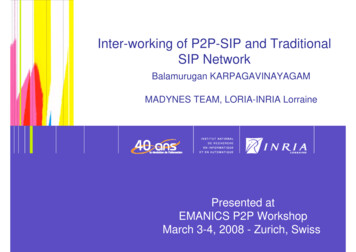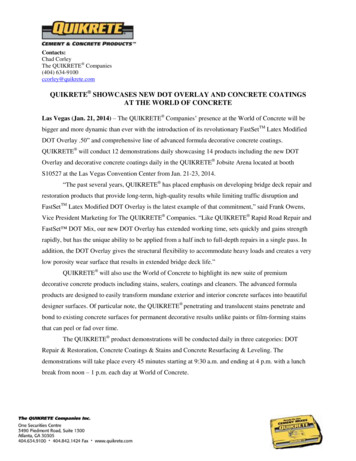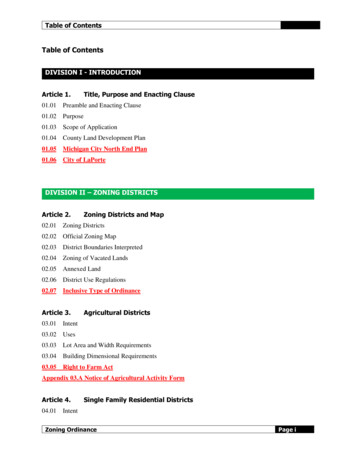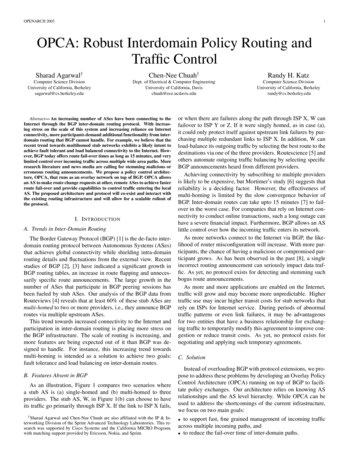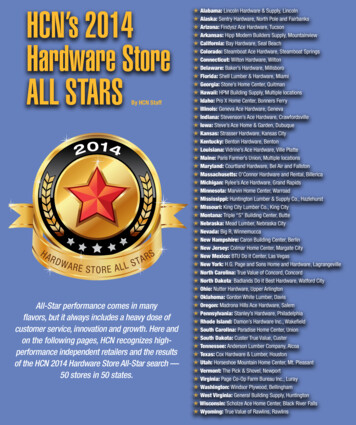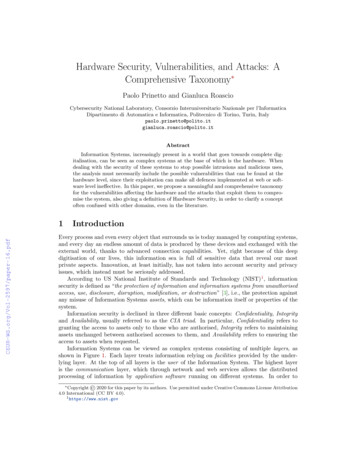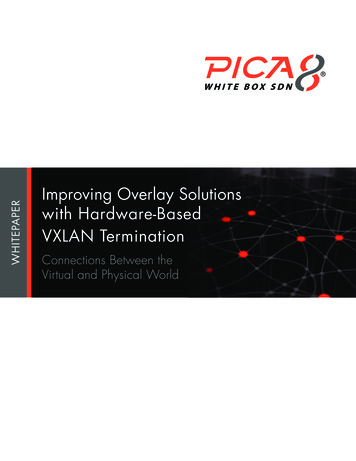
Transcription
WHITEPAPERImproving Overlay Solutionswith Hardware-BasedVXLAN TerminationConnections Between theVirtual and Physical World
AbstractAs virtualization and cloud technologies become more prevalent in today’s networkinfrastructure, the legacy network lacks agility and scale. This paper describeshow a hardware-accelerated VXLAN (Virtual Extensible LAN) solution using Pica8software on white box switches can solve those issues without performance impact.We will also explain how the growing acceptance of a standard API to control thistechnology (OVSdb) is helping the deployment of these solutions.IntroductionNetwork architectures are undergoing fundamental changes as cloud providers andlarge data centers address ever-growing mobile workloads. When workloads shift acrossphysical and virtual infrastructure like servers, storage, authentication and load-balancingdevices, new networks must reconfigure themselves on the fly based on ever-changingapplication needs. To meet this requirement, network infrastructures will continue toevolve from being hardware-bound to being software-led. It will be the software thatenables the dynamic and flexible control of the network, while the hardware providesperformance support.Operations teams typically build a software layer that defines a typical workflow toinitiate a service. But today, hardware vendors control that software and do not share anopen interface with the developer community to use its network infrastructure for servicedifferentiation (contrasting to what is possible on the server side).In addition, traditional network architectures have challenges with logical scale andprovisioning. VXLAN tries to solve the Layer-2 scale issue and VLAN limitation on thenetwork. To scale the provisioning of those tunnels, it is common to use the standardOVSdb API used by all the major overlay SDN controllers today (VMware NSX,Midokura MidoNet, OpenContrail).This white paper examines alternative software-led approaches to controlling the networkand specifically looks at the benefits of building VXLAN tunnels as a virtual network overlay.VXLAN ExplainedWhat Problems VXLAN Are Solving?Problem 1: Maximum number of VLANs in a data centerVXLAN is a standards-based Layer-2 and overlay technology, defined in RFC 7348.VXLAN provides the same Ethernet Layer-2 network services that a VLAN does, but withgreater scalability, extensibility and flexibility. It provides multi-tenancy across the datacenters by extending Layer-2 segments over Layer-3 boundaries. With VXLAN, up to 16million Layer-2 segments are possible in contrast to only 4,000 by VLANs. Therefore,VXLAN is suitable for large-scale deployments. It is also used as an overlay solution toextend Layer-2 connectivity over Layer-3 segments.1WHITEPAPER
Problem 2: Using a routing technology in a data center and keeping Layer-2connectivity for some applicationsUsing typical Layer-2 technologies for data centers is not a scalable solution (STP orMLAG). It is becoming increasingly common to use routing protocols (OSPF and BGP)in the data center (see draft-ietf-rtgwg-bgp-routing-large-dc-02 for an example of largedata center design). But even for those Layer-3 data centers, it is useful to keep Layer-2connectivity between hosts or virtual machines. This can be done with a VXLAN tunneldoing Layer-2 frame encapsulation across the Layer-3 data center.A typical example of such need is VM mobility. Moving VMs between or inside thedata center usually needs a Layer-2 segment between the two physical hosts. Creatingcombined segments over VTEPs and VXLAN enables seamless VM mobility as thecombined solution provides virtual Layer-2 across physical boundaries.VXLAN DefinedVXLAN is an overlay technology. By using UDP for transporting Layer-2 (MAC) frames,it is an MAC-in-UDP encapsulation method. In VXLAN, the original Layer-2 frame isencapsulated inside an IP-UDP packet by addingVXLAN header as shown in Figure 1.OuterMac HeaderOuterIP HeaderVXLANHeaderUDP Header14 Bytes(4 bytes optional)Original L2 FrameVLAN Type0x8100VLAN IDTagEther Type0x0800IP HeaderMisc DataProtocol0x11HeaderChecksumOuterSrc. IPOuterDst. IPUDPSrc. eservedVNIDReserved8 BytesSrc.MAC Addr.8 BytesDst.MAC Addr.20 BytesFCS484816161672816323216161616824248Figure 1. VXLAN Packet FormatThe VXLAN header is 8-bytes in length and consists of 24-bit VXLAN network identifier(VNID) and hence, provides up to 16M Layer-2 segments.VXLAN Tunnel Endpoint (VTEP)VXLAN uses VTEPs to map end devices or tenants to VXLAN and perform encapsulationand de-encapsulation functions. A VTEP consists of two interfaces: one for local LAN anda second one for an IP interface to connect to other VTEPs across an IP network. TheIP interface identifies the VTEP device by unique IP address assigned to this interface.VTEPs use the IP interface to encapsulate Layer-2 frames, and transports the resultingencapsulated packet over the IP network. Additionally, a VTEP can discover remote VTEPsfor relevant VXLAN segments, and learns remote MAC address-to-VTEP binding via IPinterface. The functional components of VTEPs and corresponding logical topology areshown in Figure 2.VxLAN & NSX architecture and configuration2
End SystemEnd SystemVTEP-3IP-3VTEP-1End System AMac-AIP-AVTEP-1IP-1VTEP-3MulticastGroupIP NetworkVTEP-2VTEP-2IP-2End System BMac-BIP-BFigure 2. VTEPVXLAN Tunnel ProvisioningVTEP Termination ProvisioningFor a specific VXLAN tunnel, only the two VTEP termination points need to beprovisioned. As for the rest of the network, the VXLAN packet is handled as a standardIP packet. A VTEP can be either a hardware VTEP (typically a TOR switch) or a softwareVTEP (typically a virtual switch on a server like OVS). It is also possible to have a VXLANtunnel between a hardware VTEP and a software VTEP. The provisioning can be donemanually, via CLI like any other networking feature, but it obviously does not scale for adynamic data center. The standard API for VTEP provisioning is the OVSDB VTEP API.What is OVSDB VTEP API?In the past, networking standards were designed by standard bodies like IETF or IEEE.As the networking industry becomes more integrated with the server and softwaretechnologies, the open source community will become more and more the sourceof network standard. OVSDB is a good example of an open source software drivenstandard.The Open vSwitch Database Management Protocol (OVSDB) is an OpenFlowconfiguration protocol designed to manage Open vSwitch implementations. BecauseOVS has become widely popular, its management protocol has become the de-factostandard API to control VTEP termination. OVSDB is a JSON RPC protocol.What is an VXLAN Overlay Solution?A VXLAN overlay solution is a mesh of tunnels built automatically by an SDN controller.Typical examples of this include Midokura MidoNet, VMware NSX or OpenContrail.Those SDN controllers connect all the data center objects like VMs, storage, loadbalancing or firewalling using common infrastructure while providing secure, seamlessconnectivity in a multi-tenant environment. This is done by creating an overlay of fullmesh, stateless tunnels between the tenant objects. Those SDN controllers address theconnectivity of the virtual switches embedded in VM host operating systems.Network overlay solutions use a policy-based method to assign network parametersto VMs, rather than use the data plane to learn them as done by legacy equipment.This approach creates an “any-to-any” connectivity between VMs. The virtual switch is3WHITEPAPER
a critical piece of this infrastructure because that is where the tunneling encapsulationand de-capsulation starts. Open vSwitch (OVS) is a good example as it assumes afully virtualized environment. Deployments are typically a hybrid environment with somenon-virtualized servers or service appliances.To connect a VM to a non-virtualized device, a network gateway is needed as atermination point for the overlay tunnel. A hardware-based VxLAN tunnel solutionis preferred because a software-based network gateway can quickly become aperformance chokepoint as it has to handle de-capsulation of the tunneling protocol atline-rate speed.Benefits of Hardware-accelerated VXLANVirtual to Physical BridgeOverlay solutions provide the creation of Layer-2 segments over Layer-3 underlays, via anative VXLAN bridge. However, it can only create these tunnels between virtual switches.Any connectivity to physical bare metal machines or network devices is not covered andrequires a gateway.In every deployment, connectivity beyond the virtual cluster is a must. While connectingmany virtual machines is the core need, most data centers require connectivity to physicalNAS for storage, external firewalls, routers and cloud management systems. Creatingcombined solutions using a PicOS-integrated gateway enables a seamless combinedsolution where the VM is unaware of the translation and seamlessly connects to anyphysical server and gateways.For a description of the PicOS architecture, please tching-overview.phpLayer 3NetworkControllerClusterRouterVXLAN Tunnel VNI 10L2 in L3VXLAN-200Switch AVXLAN-20Br-10VXLAN-5VNI 10VXLAN-20VMVMVXLAN-5VNI 10GatewaySwitch BVXLAN-200SNASABVxLAN & NSX architecture and configuration4
Software VXLAN Encapsulation Performance ImpactVXLAN uses MAC in UDP encapsulation. Since VXLAN is an additional encapsulationmechanism introduced at the hypervisor layer, there are certain performance implications.VXLAN introduces an additional layer of packet processing at the hypervisor level. Foreach packet on theVXLAN network, the hypervisor needs to add protocol headers on the sender side(encapsulation) and removethem (de-encapsulation) on the receiver side. This causes additional CPU overhead, theamount of which will vary based upon the packet size.Apart from this CPU overhead, some of the offload capabilities of the NIC cannot beused because the inner packet is no longer accessible. The physical NIC hardwareoffload capabilities (e.g., checksum offloading, TCP segmentation offload) have beendesigned for standard (non-encapsulated) packet headers, and some of these capabilitiescannot be used for encapsulated packets.In such a case, a VXLAN-enabled packet will require CPU resources to perform a taskthat otherwise would have been done more efficiently by physical NIC hardware. Thereare certain NIC offload capabilities that can be used with VXLAN, but they dependon the physical NIC and the driver being used. As a result, the performance may varybased on the hardware used when VXLAN is configured. Moving the VXLAN VTEPtunnels to ToR switches solve all those performance issues and thus is often a requirementfor high performance applications.Single ManagementVLAN configuration has always been a challenge, especially as the configuration filesizes and complexity grow exponentially. Adding more protocols only exacerbates theproblem. Managing the mapping between different technologies creates operationalnightmares and makes troubleshooting nearly impossible. A single management locationfor the configuration files can greatly simplify the process of connecting the physical andvirtual worlds using VXLAN tunnels.DocumentationFor complete configuration details for PicOS, please visit our support PAPER
Pica8, Inc. Corporate Headquarters1032 Elwell Court, Suite 105Palo Alto, California 94303 USA650-614-5838 www.pica8.com Pica8, Inc., 2015. All rights reserved.Produced in the United States 05/15.Pica8 and PicOS are trademarks of Pica8, Inc.Pica8 and PicOS trademarks are intended and authorized for use only in countries andjurisdictions in which Pica8, Inc. has obtained the rights to use, market and advertise thebrand. Pica8, Inc. shall not be liable to third parties for unauthorized use of this documentor unauthorized use of its trademarks. References in this publication to Pica8, Inc. productsor services do not imply that Pica8, Inc. intends to make these available in all countries inwhich it operates. Contact Pica8, Inc. for additional information.
As virtualization and cloud technologies become more prevalent in today's network infrastructure, the legacy network lacks agility and scale. This paper describes how a hardware-accelerated VXLAN (Virtual Extensible LAN) solution using Pica8 software on white box switches can solve those issues without performance impact.
